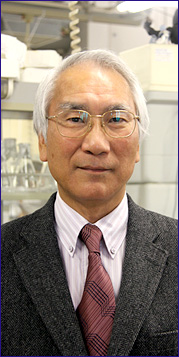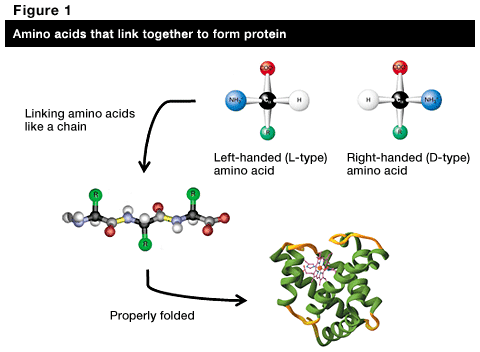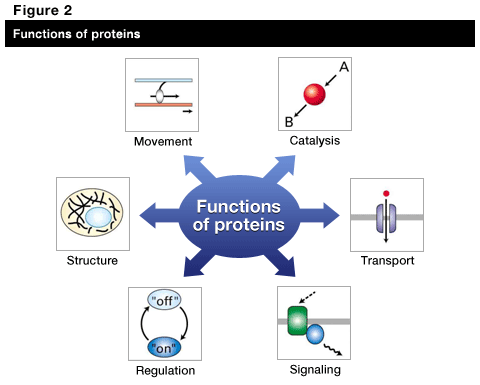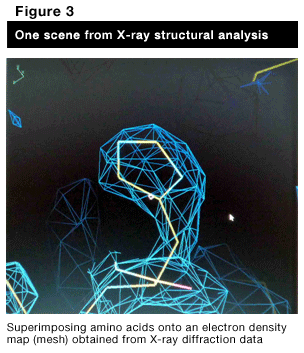

Amino Acids and Proteins
Proteins account for approximately 60% of the human body’s components except water. It is not an exaggeration to say that the human body is made up mainly of water and proteins. So what exactly are proteins? Proteins that we consume as food and that are working in our bodies are all made up of chains of amino acids (Figure 1). To synthesize proteins, 20 types of amino acids are used, of which 19 are of two types: left-handed and right-handed. Only left-handed amino acids are used to synthesize build new proteins in our bodies.
Proteins are Created in Cells and Function in Various Ways
Genetic information handed down from parents to a child is compiled in deoxyribonucleic acid (DNA), which is stored within a cell’s nucleus. DNA provides instructions for protein syntheses. Since DNA cannot leave the nucleus, cells decode instructions that are necessary for protein syntheses and take them outside the nucleus to produce proteins using 20 types of amino acids. This process occurring outside of the nucleus is called translation. Protein syntheses does not merely involve linking amino acids together. Proteins can fulfill their functions only when they are properly folded into intrinsic spatial conformations. Some proteins are also capable of attaching sugar chains and this is called the glycosylation. There are certain proteins in cells that support newly synthesized proteins so that they are folded properly. In some cases, defective proteins are still improperly folded after going through this process, and are carried to the special apparatus in cells and degraded into amino acids. Properly folded proteins are created based on such quality control mechanisms. It has been said that there are approximately 100,000 kinds of proteins that serve as the human body’s building blocks, with each protein possessing different shapes and different functions. The main items are summarized in Figure 2. Our bodies are comprised of various proteins such as those that catalyze some reactions, transport substances, signal transduction, form cells’ architecture and structural components, work as sensors or switches and induce exercise. It is the mutual collaboration of these proteins and formation of networks that enable our lives to be sustained.
Protein Research and Application

Current joint research regarding ways to make use of proteins provide the following explanations. In collaborative research with the Laboratory of Differentiation and Gene Regulation, Department of Life Sciences, we aim to establish a reactor system that is capable of glycosylation for antithrombin III (AT-III), which is used as a thrombin inhibitor. We anticipate applying the system for medical treatment and pharmaceuticals in the future. Additionally, in joint research with the Laboratory of Animal Nutritional Physiology, Department of Agricultural Chemistry, research is being conducted to help address environmental and energy-related issues. Research to date has revealed that the fungus from the rumen of Ezo deer and goats contain proteins (enzymes) which work on lignin and cellulose. In the future, we hope to make effective use of those enzymes aside from those used for food such as grain crops, thereby contributing to the production of bioethanol from cellulose and low molecular weight hydrocarbons from lignin.
Profile
Associate Professor of Department of Life Sciences, School of Agriculture, specialized in protein engineering.Born in 1947 in Ishikawa Prefecture. Completed the master’s course at the Graduate School of Science, Osaka University in 1972. Left the university after completing the full term and earning credits in the doctoral course in 1975. Assumed his current position in 2001 after fulfilling responsibilities in accordance with the Research Fellowships for Young Scientists program, Japan Society for the Promotion of Science Research; as a research member in biochemistry, University of California; and as an instructor at the Institute for Protein Research, Osaka University. Dr of Science.
Main Publications and Research Papers
“Molecular Structure of the Toxic Domain of Heat-Stable Enterotoxin Produced by a Pathogenic Strain of Escherichia coli” H. Ozaki et al., J. Biol. Chem., 266, 5934-5941 (1991).“Primary Structure of Microbial Transglutaminase from Streptoverticillium sp. Strain s-8112” T. Kanaji et al., J. Biol. Chem., 268, 11565-11572 (1993)
“Structure Characteristics for Biological Activity of Heat-Stable Enterotoxin Produced by Enterotoxigenic Escherichia coli: X-ray Crystallography of Weakly Toxic and Nontoxic Analogs” T. Sato et al., Biochemistry 33, 8641-8650 (1994).









